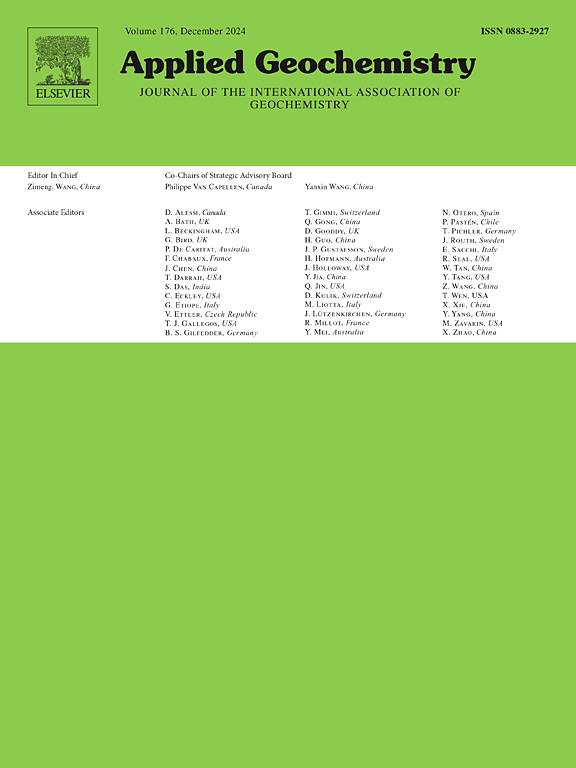Decadal transport of trace elements in a cave system based on 16 years monitoring data: Implications for paleoclimate reconstruction
IF 3.4
3区 地球科学
Q1 GEOCHEMISTRY & GEOPHYSICS
引用次数: 0
Abstract
The trace element ratios (X/Ca, X = Mg, Sr, Ba) of stalagmites are closely correlated with local hydroclimatic changes and are becoming increasingly important proxies for paleoclimate reconstruction. However, it remains unclear whether the decadal variations in the X/Ca ratios can reflect the signals of the Pacific Decadal Oscillation (PDO) and Atlantic Multidecadal Variability (AMV) in East Asia. Here, 16 years (2009–2024) of monitoring data on the trace element composition of cave water in Jiguan Cave, located in the middle and lower reaches of the Yellow River in China, were combined with an analysis of X/Ca ratios in stalagmite DSY1201 from the nearby Dongshiya Cave. The primary objective was to comprehensively explore the intricate relationship between the X/Ca ratios and the regional hydroclimatic variations. Our investigation revealed that the decadal changes in the X/Ca Principal Component 1 (PC1) exhibited a significant negative correlation with the PDO. This correlation was likely predominantly caused by the synergistic effects of prior calcite precipitation (PCP), water–rock interaction (WRI), and other factors. Notably, under drought conditions in Jiguan Cave, WRI dominates the hydro-chemical evolution of the cave water, while the reduction in the recharge flux and the prolongation of the water residence time jointly induce a marked enhancement in the X/Ca ratios. Correlation analysis further demonstrated that the PDO significantly modulates the amplitude of the X/Ca-PC1 variability by regulating the frequency of extreme precipitation or drought events during critical years. In addition, the multi-proxy records (X/Ca-PC1, δ13C, and δ18O) from stalagmite DSY1201 revealed similar relationships and patterns in the AMV and PDO phase transitions during the 1960s and late 1990s. Thus, we ultimately suggest that the AMV and PDO play important roles in the decadal variations in the intensity of the East Asian summer monsoon (EASM) and the spatial pattern of the EASM rainfall, in combination with the AMV-Northern Hemisphere (ANH) teleconnection and the Pacific-East Asia (PEA) teleconnection, respectively. This may be recorded by the X/Ca ratios in the karst cave systems in the EASM area.
基于16年监测数据的洞穴系统中微量元素的年代际迁移:对古气候重建的意义
石笋微量元素比值(X/Ca, X = Mg, Sr, Ba)与当地水文气候变化密切相关,已成为古气候重建的重要指标。然而,东亚地区X/Ca比值的年代际变化是否能反映太平洋年代际涛动(PDO)和大西洋多年代际变率(AMV)的信号尚不清楚。本文利用2009-2024年16年黄河中下游鸡冠洞洞水微量元素组成监测资料,结合东石崖洞DSY1201石笋X/Ca比值分析。主要目的是全面探讨X/Ca比值与区域水文气候变化之间的复杂关系。结果表明,X/Ca主成分1 (PC1)的年代际变化与PDO呈显著负相关。这种相关性可能主要是由先前方解石降水(PCP)、水岩相互作用(WRI)和其他因素的协同作用引起的。值得注意的是,在干旱条件下,济关洞水的水化学演化中,WRI占主导地位,而补给通量的减少和水停留时间的延长共同导致了X/Ca比值的显著提高。相关分析进一步表明,PDO通过调节关键年极端降水或干旱事件的频率,显著调节X/Ca-PC1变率的幅度。此外,DSY1201石笋的X/Ca-PC1、δ13C和δ18O多代记录也揭示了60年代和90年代后期AMV和PDO相变的相似关系和模式。因此,我们最终认为,AMV和PDO分别与AMV-北半球(ANH)遥相关和太平洋-东亚(PEA)遥相关在东亚夏季风(EASM)强度和降水空间格局的年代际变化中发挥了重要作用。这可以通过东亚东部地区溶洞系统的X/Ca比值来记录。
本文章由计算机程序翻译,如有差异,请以英文原文为准。
求助全文
约1分钟内获得全文
求助全文
来源期刊

Applied Geochemistry
地学-地球化学与地球物理
CiteScore
6.10
自引率
8.80%
发文量
272
审稿时长
65 days
期刊介绍:
Applied Geochemistry is an international journal devoted to publication of original research papers, rapid research communications and selected review papers in geochemistry and urban geochemistry which have some practical application to an aspect of human endeavour, such as the preservation of the environment, health, waste disposal and the search for resources. Papers on applications of inorganic, organic and isotope geochemistry and geochemical processes are therefore welcome provided they meet the main criterion. Spatial and temporal monitoring case studies are only of interest to our international readership if they present new ideas of broad application.
Topics covered include: (1) Environmental geochemistry (including natural and anthropogenic aspects, and protection and remediation strategies); (2) Hydrogeochemistry (surface and groundwater); (3) Medical (urban) geochemistry; (4) The search for energy resources (in particular unconventional oil and gas or emerging metal resources); (5) Energy exploitation (in particular geothermal energy and CCS); (6) Upgrading of energy and mineral resources where there is a direct geochemical application; and (7) Waste disposal, including nuclear waste disposal.
 求助内容:
求助内容: 应助结果提醒方式:
应助结果提醒方式:


